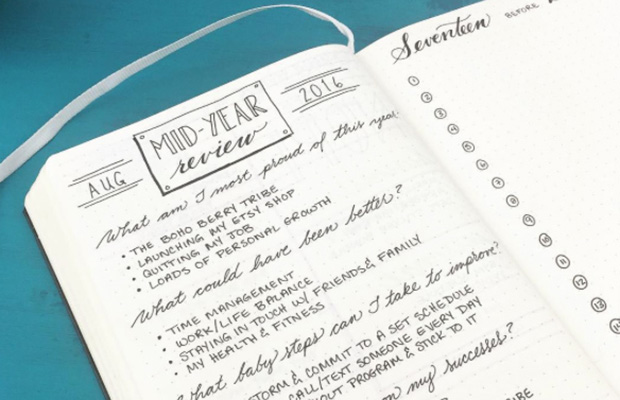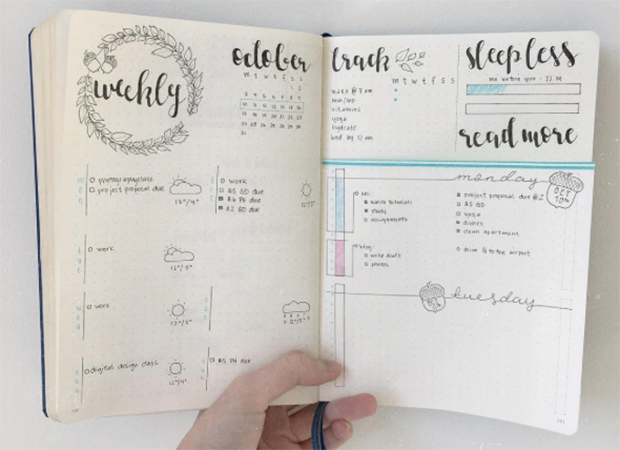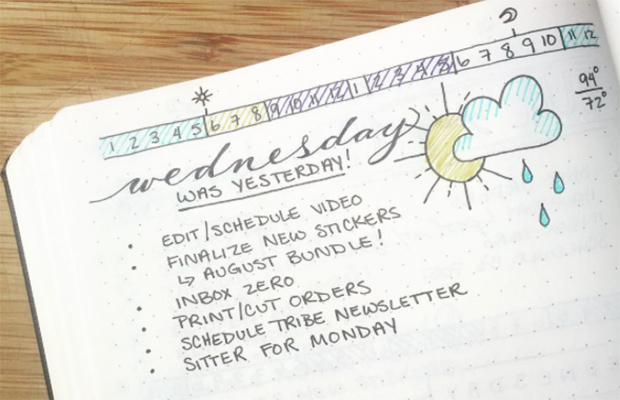
Yana Weinstein’s search for the perfect planner left her feeling like Goldilocks. This notebook was too big. This layout was too small. Online to-do lists quickly lost their appeal. So when she read about the Bullet Journal on Facebook, the 33-year old assistant professor of psychology at The University of Massachusetts and founder of The Learning Scientists decided to give it a shot. After one month using the pen and paper system, she was sold. “I’m more productive and organized,” she says.
The Bullet Journal (better known as BuJo to its cult of followers) is taking over Instagram and Pinterest feeds everywhere. While it may sound like a sibling of bulletproof coffee, it’s its own entity — a calendar/to-do list/journal/notebook hybrid that you design and use to organize your life.
If the pretty photos aren’t enough to convince you to test it out, the potential benefits might. Here’s what you need to know about the productivity hack du jour.
RELATED: 7 Daily Habits That Are Sabotaging Your Mental Health

The Bullet Journal Basics
When traditional note-taking didn’t work for Brooklyn-based designer Ryder Carroll, he developed a more efficient system to capture his ideas. Over the years, he’s refined his method into what’s now known as the Bullet Journal. (For a brief overview of exactly how he starts a Bullet Journal, check out this video, also seen below.)
Carroll describes his form of journaling as “a framework for tracking the past, organizing the present and preparing for the future.” While it sounds ambitious, all you really need is a blank notebook and a pen. (Major BuJo fans prefer Moleskine, Leuchtturm 1917 or Bullet Journal’s own notebooks.) Think of it as your personalized shorthand for what you need to do each day and for getting thoughts from your head to the paper.
A traditional bullet journal has four main modules:
1. Future Log: Your big picture overview of the year’s major events and goals.
2. Monthly Log: A calendar as well as a list of tasks and goals, giving you a birds-eye view of the current 30 days.
3. Daily Log: The perfect way to keep track of the next 24 hours of events, tasks and notes. When you finish a task, mark it complete. If you don’t finish something? Move the task to the next day, week or month. (FYI, some avid bullet journalers opt for a weekly spread instead of daily.)
4. Index: The backbone of your bullet journal, pulling everything together into a list so you can easily locate sections in your notebook, even when related pages aren’t grouped together.
The beauty of a bullet journal, though, is that it’s completely customizable. Don’t like bullets? Make ‘em stars. Have a bunch of restaurants you want to go to? Keep a running list. Prefer to color each task you complete in ombré shades? Go for it. A quick search of #bulletjournaljunkies on Instagram reveals endless snaps of how BuJo aficionados have taken their blank pages beyond bulleted lists to track everything from hydration to workouts to meal planning to must-read books.
RELATED: 5 Brilliant Apps to Make Meal Planning Easy

The Write Way to Boost Productivity
There are endless ways to keep tabs on your appointments, deadlines, to-do lists, goals and even habits, from Post-It notes to online journals to wearables. But a bullet journal merges those scattered systems into one, which can escalate your productivity.
“All the different technology and distractions has us pulled apart and spread thin,” says Nicole Amesbury, MS, licensed mental health counselor and head of clinical development for Talkspace. “With a bullet journal, it is one place where you have structure. It’s yours. Everything is in one place and that’s really resonating with people.” Plus, because you’re incorporating various elements into your BuJo — lists, graphs, doodles — Amesbury says you stimulate your brain in different ways, which can help you learn and remember things better.
RELATED: How to Deal with Stress and Make It Work in Your Favor
The act of migrating and rewriting unfinished tasks also makes you stop and consider whether each item on your list is worth your time. It’s the bullet journal way of helping you prioritize your life. And letting go of some unnecessary tasks can help you de-stress.
“With an online to-do list, I can click a button and the deadline would change and I would forget about it,” says Weinstein. “Now, when I see a task indented by three arrows (indicating it’s been migrated), it sticks out. Do I need to do it, delegate it or rethink it?” she says. Seeing what you’ve put off or what you accomplished serves as a powerful motivator to keep working hard.
RELATED: 9 Mantras to Find Zen from Gabrielle Bernstein’s New Book

Bullet Journaling to Put Your Mind at Ease
Using a bullet journal to write down your feelings or what you’re stressed about can help you find some peace. It’s worked for Weinstein: She uses a circle to make note of her worries. “When it’s resolved, I can fill in the circle. Over the day, I can see that they aren’t concerns anymore,” she says.
Unloading all your fears onto the page can make it easier to move forward. “You haven’t gotten rid of [your worries] but you’ve put them in their place,” says Amesbury. In fact, research shows that journaling can have long-term physical and psychological benefits such as improved mood, fewer stress-related visits to the doctor and a greater sense of psychological wellbeing.
“You’re constructing a future for yourself,” says Amesbury, who explains that those suffering from depression may have trouble picturing what’s ahead. “The bullet journal allows them to see themselves out of the current circumstances, and it provides a sense of structure and schedule.” According to Amesbury, that schedule should include self-care too. “Take note of things like sleep, writing and exercise,” she says. “It’s really important when people think not just of what they have to do, but what they want to do, too.”
RELATED: 8 Signs You’re Way Too Stressed (And How to Deal)
Make It Your Own
It’s easy to tumble down the bullet journal rabbit hole, scrolling through picture after picture of beautiful layouts, handwriting and doodles. But remember, an Instagram snap is just that — a photo.
“If you feel like you have to make it perfect and pretty and you’re comparing it to pictures on Instagram, bullet journaling may not be for you,” says Amesbury. “The point is to have a personal place to express yourself.” If that means scribbles instead of beautiful script, so be it!
